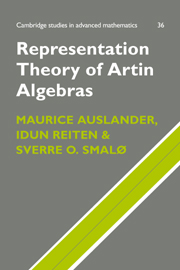Book contents
- Frontmatter
- Contents
- Introduction
- I Artin rings
- II Artin algebras
- III Examples of algebras and modules
- IV The transpose and the dual
- V Almost split sequences
- VI Finite representation type
- VII The Auslander–Reiten-quiver
- VIII Hereditary algebras
- IX Short chains and cycles
- X Stable equivalence
- XI Modules determining morphisms
- Notation
- Conjectures
- Open problems
- Bibliography
- Relevant conference proceedings
- Index
Introduction
Published online by Cambridge University Press: 11 May 2010
- Frontmatter
- Contents
- Introduction
- I Artin rings
- II Artin algebras
- III Examples of algebras and modules
- IV The transpose and the dual
- V Almost split sequences
- VI Finite representation type
- VII The Auslander–Reiten-quiver
- VIII Hereditary algebras
- IX Short chains and cycles
- X Stable equivalence
- XI Modules determining morphisms
- Notation
- Conjectures
- Open problems
- Bibliography
- Relevant conference proceedings
- Index
Summary
A major concern of elementary linear algebra is the description of how one linear transformation can act on a finite dimensional vector space over a field. Stated in simplest terms, the central problem of this book is to describe how a finite number of linear transformations can act simultaneously on a finite dimensional vector space. While the language of linear algebra suffices in dealing with one transformation on a vector space, it is inadequate to the more general task of dealing with several linear transformations acting simultaneously. As so often happens, when straightforward approaches to seemingly simple problems fail, one adopts a more devious strategy, usually involving a more abstract approach to the problem. In our case, this more abstract approach is called the representation theory of finite dimensional algebras, which in its broadest terms is the study of modules over finite dimensional algebras. One of the advantages of the module theoretic approach is that the language and machinery of both category theory and homological algebra become available. While these theories play a central role in this book, no extensive knowledge of these subjects is required, since only the most elementary concepts and results, as contained in most introductory courses or books on homological algebra, are assumed.
Although many of the concepts and results presented here are of recent origin, having been developed for the most part over the past twenty-five years, the subject itself dates from the middle part of the nineteenth century with the discovery of the quaternions, the first noncommutative field, and the subsequent development, during the first part of this century, of the theory of semisimple finite dimensional algebras over fields.
- Type
- Chapter
- Information
- Representation Theory of Artin Algebras , pp. xi - xivPublisher: Cambridge University PressPrint publication year: 1995

